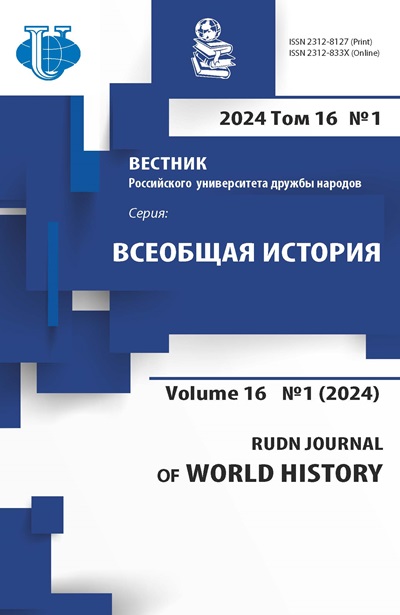Principles of spatial organization and agrarian structure of Ancient Rome
- Authors: Gvozdeva I.A.1
-
Affiliations:
- Lomonosov Moscow State University
- Issue: Vol 10, No 3 (2018)
- Pages: 219-228
- Section: Antique world
- URL: https://journals.rudn.ru/world-history/article/view/20671
- DOI: https://doi.org/10.22363/2312-8127-2018-10-3-219-228
Cite item
Full Text
Abstract
In archaic societies the idea of the spatial organisation was embodied in the cosmogony and was accompanied by a complicated ritual. The Romans embraced the principles of spatial thinking from the Etruscans inherited from them also ritual. In ancient traditions, it is this ritual which have obscured the main ideas on division of space. Reconstruction of the heavenly temple on earth made by the priest largely depended on his individual perception of this task. Adapting the projection of the celestial temple to the spatial division, the Romans gradually began to get rid of the undefined elements of the ritual. Now it was focused on conducting of the principal axes, namely on their orientation towards the four cardinal points. First one held the line designating the East-West, then the perpendicular line North-South. Thus was created the cross of divisors with confined spaces, i.e. coordinate system. The main element of the theory of the Roman spatial division was the limit - a straight line, just held on geographical areas. All limits (main and parallel) precisely defined section of land. In practice, the Roman surveyors carefully spaced and accurately divided areas with limits. These principles are used by the Romans in the organization of the lands in Italy and in the provinces.
About the authors
Inna Andreevna Gvozdeva
Lomonosov Moscow State University
Author for correspondence.
Email: innagvozdeva@mail.ru
PhD in Historical Sciences
27-4 Lomonosovsky Ave., Moscow, 119991, Russia, GSP-1References
- Gvozdeva I.A. Tehnicheskie aspekty zemleustrojstva v drevnem Rime po traktatam zemlemerov [The Technical aspects of land management in ancient Rome, the tracts of land] // Vestnik Moskovskogo Universiteta. Serija 8. Istorija [Vestnik of Moscow University. Series 8. History]. M.,1979. №. 4. S. 74–88.
- Gvozdeva I.A. Rannie tipy delenija zemel’nyh ploshhadej pri organizacii sel’skoj territorii u rimljan [Types of Early division of land in rural areas among the Romans] // Vestnik Moskovskogo Universiteta. Serija 8. Istorija [The Moscow University Herald. Series 8. History]. M., 1986. №. 2. S. 80–91.
- Gvozdeva I.A., Gvozdeva T.B. Terminus – ohranitel’ rimskih granic [Terminus – guardian of the Roman borders] // Antiquitas aeterna. Povolzhskij antikovedcheskij zhurnal. Vyp. 4. Istorija ponjatij, kategorial’nyj apparat sovremennoj istoricheskoj nauki i problemy (re)konstrukcii proshlogo [Antiquitas aeterna. Povolzhskiy journal of classical studies. Vol. 4. History of concepts of categorical apparatus of modern historical science and problems of (re)construction of the past]. N. Novgorod, 2014. P. 249–268.
- Gvozdeva T.B. Mezhevoj znak v sisteme rimskogo zemel’nogo prava [Landmark sign in the system of Roman land law] // Agrarnoe i zemel’noe pravo [Agrarian and land law]. M., 2015. №. 12 (132). P. 53–56.
- Beaudouin E. La limitation des fonds de terre dans ses rapport avec le droit de propriete. P.: Larouze, 1894.
- Bloch R. The Etruscans. L.: Thems & Hudson, 1965.
- Bouché-Leclercq A. Histoire de la divination dans l’antiquité. Vol. 1–4. P.: Leroux, 1879–1882. Vol. 4. Divination Italique, 1882.
- Castognoli F. La ricerche sui resti della centuriazione. Roma: Ed. di storia e litteratura, 1958.
- Fraccaro P. Agrimensura. In: Encoclopedia Italiana di scienza, lettere ed arti. Vol. 1. Milano, 1929.
- Morris J. Shaping the Empire: Agrimensores, Emperors and the Creation of the Roman Provincial Identities. Ph. D. diss.: University of Leicester, 2016.
- Nissen H. Das Templum. B., 1865.
- Piganiol A. Les documents cadastraux de la colonie romaine d’Orange. P., 1962.
- Rose H. J. Ancient Roman Religion. L., 1949.
- Scullard H.H. The Etruscan cities and Rome. L.: Thames & Hudson, 1967.
- Thulin C. Die Etruskische Disciplin. Vol. I–III. Göteborg, 1905–1908. Vol. III.













